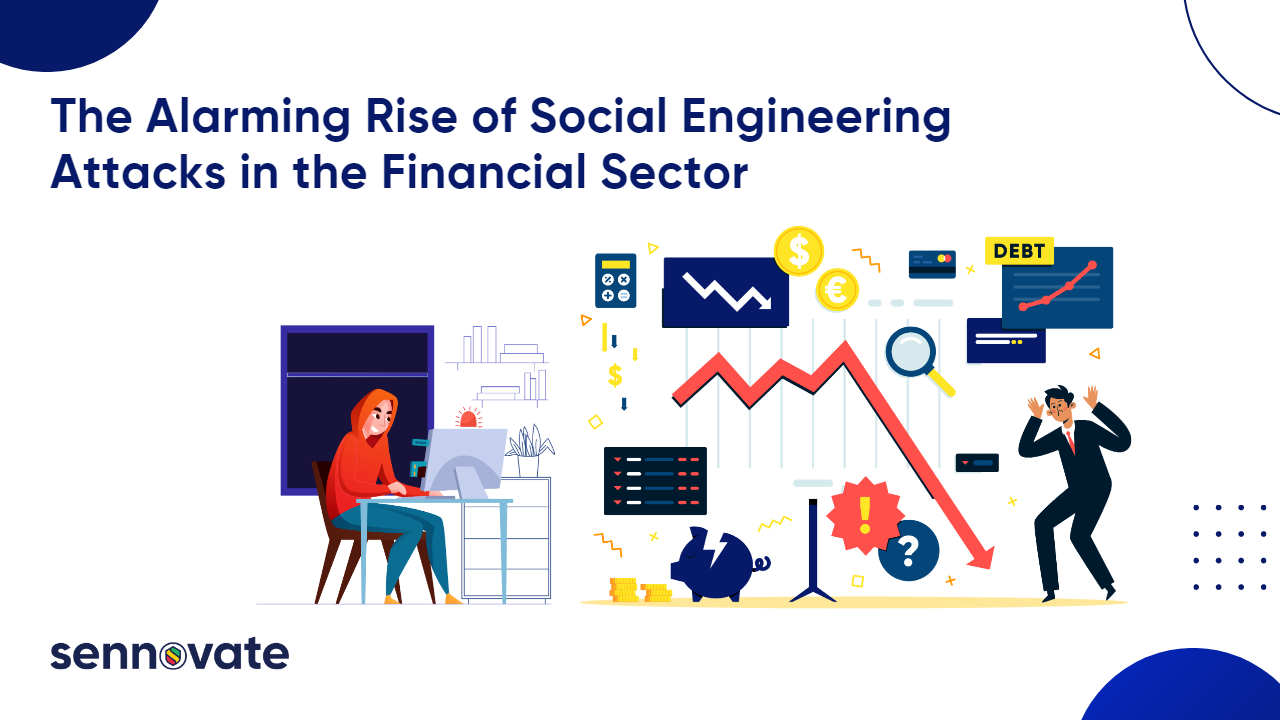
The Alarming Rise of Social Engineering Attacks in the Financial Sector
Gone are the days of masks and guns for bank and financial institutions robberies. Criminals have shifted to more sophisticated methods to get funds and data. They have shifted from masks and guns to social engineering attacks for scripts and ransomware. From the past few years, there is a drastic increase in the rate of attempted social engineering attacks and hacks in the financial sector.
It is crucial to provide quality customer service for the financial services industry, but there are many potential pitfalls when your employees go above and beyond for your customers. There is a huge number of sensitive assets that banks or any other financial institution rely on every day to conduct business. These include social security numbers, credit information, PINs, cardholder data, mailing addresses, email addresses, account balances, and more. All these assets are available and accessible to employees, which means that it is susceptible to being compromised by a malicious hacker. Because of these reasons, it is important to focus on social engineering training for financial sector employees. This will educate them on how to identify and report social engineering attempts.
You must be wondering what social engineering is? What are common types of social engineering attacks in the financial sector? How can the financial sector mitigate the risks of these attacks? No worries! This blog has answers to all your questions.
Let’s dig in!
What is Social Engineering?
Social engineering is a type of attack that takes place due to human interaction and usually involves manipulating people into breaking normal security procedures and best practices to gain unauthorized access to systems, networks or physical locations or for financial gain.
To hide their real identities and motives, threat actors use social engineering techniques and they present themselves as trusted individuals or information sources. The reason behind this is to influence, manipulate or trick users so that they reveal sensitive data or access within an enterprise.
Attackers use social engineering tactics as it is usually easier to exploit your natural inclination to trust than it is to discover ways to hack your software. For instance, it is much easier to trick anyone into giving you their password than it is for you to try hacking their password.
Types of Social Engineering Attacks in Financial Sector
The below-mentioned are the types of social engineering attacks that could happen at a financial institution. Let’s have a look.
1. Website Spoofing
Website spoofing is usually combined with phishing emails. When a malicious hacker creates a website that looks almost similar to an original website in both design and web address, website spoofing occurs. This can be very troublesome for the financial services industry because of the sensitive nature of the data used to conduct business. For instance, if an employee receives an email that directs them to their company website (i.e. www.wellfrog.com), but the link provided in the phishing email is www.welllfrog.com. Most of the employees may not be able to spot the difference between the two URLs before clicking on the link and may lose their credentials.
2. Email
To gain access to an enterprise’s systems or network by compromising the login credentials of an employee or group of employees is the main goal of phishing. Emails are often not easy to identify as they contain corrupt links or files and are sent under the disguise of senior management. For instance, let us assume that an employee who has worked at your bank for over 15 years receives an email that requests that he verify his login credentials immediately or else his account will be suspended. Even though this employee has never received an email like this before, the urgency of the request coupled with a fear of being locked out of the network he needs to fulfill his duties influences him to click on the malicious link in the email which leads to a major data breach.
3. Physical Attack
In the financial sector industry, Physical attacks are just as much of a threat as phishing attacks. Consider the variety of people i.e. customers, vendors, employees, etc. that walk into a financial institution every day.. A malicious hacker, for instance, may enter into a bank disguised as an IT professional. If employees are not properly trained on proper policies and procedures for dealing with outside IT professionals, such as verifying identity, they may give the unverified third party access to their computer.
How To Mitigate The Social Engineering Attack Risks?
1. Educate your employees about the risks
Employee education is usually the overlooked component of cyber security even though it is very important. You have to educate your employees in order to protect your financial institution. One should ensure that employees are aware of these social engineering threats and that they understand how the attacks play out.
2. Initiate fake social engineering attacks
Give your employees hand-on training by sending them the fake attacks instead of just telling your employees about the risks. You can see those employees who are the most vulnerable by sending out the fake attacks. You can also see whom to focus more during your next employee education session. You can do this on your own or a cyber security specialist can help you.
3. Update your customer messaging
One of the most easy ways for thieves to gain access to personal and sensitive data is through social engineering attacks. These attacks can take a wide range of forms. But as mentioned above, these attackers generally focus on getting account holders to share information or take a certain action.
In most circumstances, your financial institutions will not be liable for these losses, but it is never in your best interest for your customers’ accounts to become overdrawn. Whenever that happens, there is a risk the customer will walk away, and you’ll be stuck with the losses.
4. Leverage cyber intelligence
Cyber attackers are always improving their skills. It is necessary for them if they want to be successful. But they don’t work in silos. They often share information about their tactics and strategies on the dark web or in hacker forums.
To protect your financial institutions and your customers from these attacks, you have to understand what the criminals are doing, and cyber threat intelligence can help you with this. By monitoring the public and private data sources to know about the threats facing your financial institutions and your customer, cyber threat intelligence can safeguard you.
Summing Up
Even with the best security practices in place, your business may still fall victim to social engineering attacks. You have to be ready before it happens. Sennovate has deep expertise in social engineering and fraudulent instruction schemes, and can offer solutions to protect your sensitive data and your customer’s privacy.
Do you want to start taking the right precautions to protect your business from unwanted social engineering attacks but don’t know how to do it? No worries! Sennovate experts are here to help you.
Having any doubts or want to have a call with us to know more about our Security Awareness Training to conquer Social Engineering Attacks?
Contact us right now by clicking here, Sennovate’s Experts will explain everything on call in detail.
You can also write a mail to us at [email protected] or call us on +1 (925) 918-6618.
About Sennovate
Sennovate delivers custom Identity and Access Management (IAM), Managed Security Operations Center (SOC) solutions, Social Engineering Defence (SED) services to businesses around the world. With global partners and a library of 2000+ integrations, 10M+ identities managed, we implement world-class cybersecurity solutions that save your company time and money. We offer a seamless experience with integration across all cloud applications, and a single price for product, implementation, and support. Have questions? The consultation is always free. Email [email protected] or call us at: +1 (925) 918-6618.

